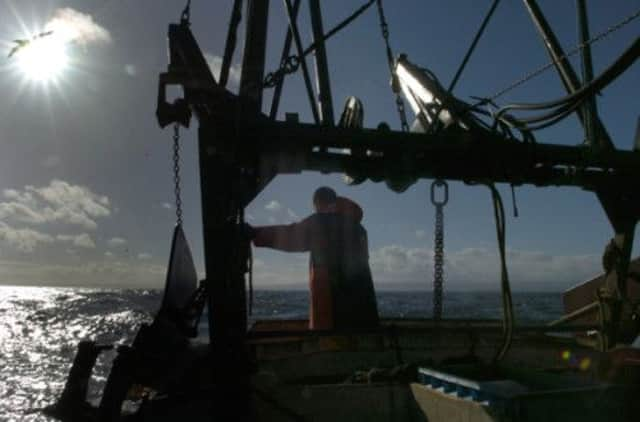Murray Roberts: We need to protect Scottish sea-bed


As 2013 Year of Natural Scotland ends, we have a unique opportunity for Scotland, and Europe, to lead the world in conserving deep-sea biodiversity. Next Tuesday the European Parliament will vote on a proposal to phase out deepsea bottom trawling and gillnet fishing.
In March 2013, the parliament’s environment committee voted 58-1 to phase-out deep-sea bottom trawling in EU waters and by EU vessels fishing the north-east Atlantic. The fisheries committee rejected the proposal last month. The vote next week will decide whether deep-sea trawling and gillnet fishing will end or will continue for at least the next eight to ten years.
Advertisement
Hide AdAdvertisement
Hide AdScotland’s territorial seabed is almost six times greater than its land area, making Scotland responsible for most of the UK’s deep-seabed. But this is no longer a pristine wilderness. Scotland’s seabed shows the scars of bottom trawling to catch long-lived, slow growing deep-sea species that are vulnerable to over-fishing. Deep-sea fish are caught primarily by French and Spanish trawlers. They are a tiny proportion of total landings and the fisheries only take place because they are subsidised by the EU taxpayer.
In 1998, as a young researcher, I had the chance to survey the seabed 100 miles north-west of the Hebrides. It was a first glimpse into another world, a part of Natural Scotland seen by only a handful of people.
As you sail west of the Hebrides you traverse the 100-200m deep continental shelf. Between 50 and 100 miles west, the waters rapidly deepen as you cross the shelf edge and descend the continental slope. My 1998 survey photographed these places, the largest ecosystems in Natural Scotland.
At 720m deep the photos revealed boulders on the seabed, relics of icebergs at the end of the last ice age. Each was festooned in sponges and other delicate animals feeding from the water column. At just over one kilometre deep, the muddy seabed was covered in strange domes made of a delicate tracery of sand and mud built by giant single-celled creatures known as xenophyophores. Beyond these were areas 1.3km deep where glass sponges grow, each colonised by other animals making tiny high-rise apartments built by living creatures growing out of an otherwise flat muddy seabed.
But the real surprise was that in many places almost half the photographs of the seabed showed scars cutting across the bottom with gouges taken out of the sediment and the dead stalks of glass sponges protruding into the water. Other areas were covered in regular grooves showing that something large and heavy had been dragged across the seabed – the net, cables, and doors of fishing trawls.
This was the first direct evidence of the impact of deep-sea trawling on the seabed in Scottish waters. Scotland’s deep seas have been fished for more than 30 years. Deep-water fish have declined with some sharks now recognised as endangered (Portuguese dogfish) or critically endangered (gulper shark). Catches follow characteristic cycles of boom in the early days and bust as the populations are fished down.
Why is this? The pace of life in the deep-sea is slow. Food rains down from the surface waters and deep-sea animals are adapted with slow growth, long lifespans and low rates of reproduction. To be sustainable, harvest rates from most deep-sea fisheries must be very, very low. Because deep-sea fish live in mixed populations it is also hard to target any one species without catching many others, leading to off-quota species being thrown overboard.
When you consider this alongside the destructive impact of seabed trawling, the case that this can be a sustainable fishery all but disappears. But the final case for sustainability must include the economic and social benefit of deep-sea fishing. The combined catch of fish from the water column and seabed from the seas around Rockall, Bailey and the Faroe-Shetland Channel is just 8 per cent of the value of the catch landed in Scotland, and most of this catch corresponds to shallow stocks of haddock and monkfish. By far the largest share of deep-sea fish quotas in Scottish waters are held by the French and Spanish.
Advertisement
Hide AdAdvertisement
Hide AdBut despite all this there remain reasons for optimism. Over the last decade deep-sea conservation has climbed the agenda with concern over unregulated fishing of international waters leading to United Nations resolutions calling for conservation of Vulnerable Marine Ecosystems (VMEs). Through the EU, Scotland and the UK have worked to create Atlantic protected areas where trawling is banned to protect VMEs, including deep-water coral reefs. Further areas are proposed through the Scottish Marine Protected Area Network, although the management plans have yet to be agreed.
While we await decisions on how the new areas will be protected, we have a responsibility to conserve Natural Scotland and show international leadership in deep-sea conservation. This is not just to preserve fish populations or the strange fields of xenophyophores, but to ensure our legacy to future generations. A hundred years ago few would have given any value to the slimy bacterial mats that grow by the hot springs in Yellowstone National Park. Yet the heat resistant enzymes extracted from these bacteria laid the foundations of today’s biotechnology industry. Compounds extracted from deep-sea species are now being tested as potential anti-cancer therapies. We hold biodiversity in trust for generations to come. But whether our children inherit these options depends upon the choices and decisions we make in 2013, Year of Natural Scotland.
• Murray Roberts is professor of marine biology and director of the Centre for Biodiversity & Biotechnology at Heriot-Watt University